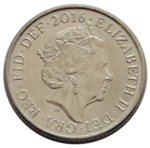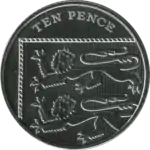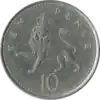Ten pence (British coin)
The British decimal ten pence coin (often shortened to 10p in writing and speech) is a denomination of sterling coinage worth 1⁄10 of a pound. Its obverse has featured the profile of Queen Elizabeth II since the coin's introduction in 1968, to replace the florin (two shilling) coin in preparation for decimalisation in 1971.[1] It remained the same size as the florin coin (which also remained legal tender) until a smaller version was introduced 30 September 1992, with the older coins being withdrawn on 30 June 1993.[2] Four different portraits of the Queen have been used on the coin; the latest design by Jody Clark was introduced in 2015. The second and current reverse, featuring a segment of the Royal Shield, was introduced in 2008.
United Kingdom | |
| Value | £0.10 |
|---|---|
| Mass | (1968–1992) 11.31 g (1992–present) 6.5 g |
| Diameter | (1968–1992) 28.5 mm (1992–present) 24.5 mm |
| Thickness | (Cupro-nickel) 1.85 mm (Steel) 2.05 mm |
| Edge | Milled |
| Composition | Cupro-nickel (1971–2010) Nickel-plated steel (2011–) |
| Years of minting | 1968–present |
| Obverse | |
 | |
| Design | Queen Elizabeth II |
| Designer | Jody Clark |
| Design date | 2015 |
| Reverse | |
 | |
| Design | Segment of the Royal Shield |
| Designer | Matthew Dent |
| Design date | 2008 |
The ten pence coin was originally minted from cupro-nickel (75% Cu, 25% Ni), but since 2012 it has been minted in nickel-plated steel due to the increasing price of metal. From January 2013 the Royal Mint began a programme to gradually remove the previous cupro-nickel coins from circulation and replace them with the nickel-plated steel versions.[3]
As of March 2014, there were an estimated 1,631 million 10p coins in circulation, with an estimated face value of £163.08 million.[4]
10p coins are legal tender for amounts up to the sum of £5 when offered in repayment of a debt; however, the coin's legal tender status is not normally relevant for everyday transactions.
Design
Obverse
To date, four different obverses have been used. In all cases, the inscription until 2015 was ELIZABETH II D.G.REG.F.D.,[5] followed by the year of minting. In the original design both sides of the coin are encircled by dots, a common feature on coins, known as beading.
As with all new decimal currency, until 1984 the portrait of Queen Elizabeth II by Arnold Machin appeared on the obverse,[6] in which the Queen wears the 'Girls of Great Britain and Ireland' Tiara.
Between 1985 and 1997 the portrait by Raphael Maklouf was used,[6] in which the Queen wears the George IV State Diadem.
On 30 September 1992 a reduced-size version of the 10 pence coin was introduced. The older and larger version of the coin was withdrawn from circulation on 30 June 1993. The design remained unchanged.
From 1998 to 2015 the portrait by Ian Rank-Broadley was used,[6] again featuring the tiara, with a signature-mark IRB below the portrait.
As of June 2015, coins bearing the portrait by Jody Clark have been seen in circulation.
Reverse

Original Reverse Design
The original reverse of the coin, designed by Christopher Ironside, and used from 1968 to 2008, is a crowned lion (formally, Part of the crest of England, a lion passant guardant royally crowned), with the numeral "10" below the lion, and either NEW PENCE (1968–1981) or TEN PENCE (1982–2008) above the lion.
Royal Shield Design
In August 2005 the Royal Mint launched a competition to find new reverse designs for all circulating coins apart from the £2 coin.[7] The winner, announced in April 2008, was Matthew Dent, whose designs were gradually introduced into the circulating British coinage from mid-2008.[8] The designs for the 1p, 2p, 5p, 10p, 20p and 50p coins depict sections of the Royal Shield that form the whole shield when placed together. The shield in its entirety was featured on the now-obsolete round £1 coin. The 10p coin depicts part of the first quarter of the shield, showing two of the lions passant from the Royal Banner of England, with the words TEN PENCE above the shield design. The coin's obverse remains largely unchanged, but the beading (the ring of dots around the coin's circumference), which no longer features on the coin's reverse, has also been removed from the obverse.
A to Z Design (Great British Coin Hunt)
In March 2018, new designs were released, one for each of the 26 letters of the alphabet. Anne Jessopp, chief executive of the Royal Mint, described the designs as "iconic themes that are quintessentially British". The A to Z coins were confirmed to have individual mintage figures of 220,000 on 14 October 2019 - a total of 5,720,000 for all 26.[9][10]
- A – Angel of the North
- B – Bond... James Bond
- C – Cricket
- D – Double-decker bus
- E – English breakfast
- F – Fish and chips
- G – Greenwich Mean Time
- H – Houses of Parliament
- I – Ice cream
- J – Jubilee
- K – King Arthur
- L – Loch Ness Monster
- M – Mackintosh
- N – NHS
- O – Oak tree
- P – Post box
- Q – Queuing
- R – Robin
- S – Stonehenge
- T – Tea
- U – Union Flag
- V – Village
- W – World Wide Web
- X – X marks the spot
- Y – Yeoman Warder
- Z – Zebra crossing
King Charles III definitive design
In October 2023 the King Charles III ten-pence coin was presented; the coin features a capercaillie. [11][12]
Status as legal tender
10p coins are legal tender for amounts up to and including £5.[13][14] However, in the UK, "legal tender" has a very specific and narrow meaning which relates only to the repayment of debt to a creditor, not to everyday shopping or other transactions.[15] Specifically, coins of particular denominations are said to be "legal tender" when a creditor must by law accept them in redemption of a debt.[16] The term does not mean - as is often thought - that a shopkeeper has to accept a particular type of currency in payment.[15] A shopkeeper is under no obligation to accept any specific type of payment, whether legal tender or not; conversely they have the discretion to accept any payment type they wish.[14]
Mintages
| Year | Number minted | Composition | Diameter (mm) | Portrait | Reverse |
|---|---|---|---|---|---|
| 1968 | 336,143,250 | Cupro-nickel | 28.5 | Machin | Ironside |
| 1969 | 314,008,000 | ||||
| 1970 | 133,571,000 | ||||
| 1971 | 63,205,000 | ||||
| 1972 | 0 | ||||
| 1973 | 152,174,000 | ||||
| 1974 | 92,741,000 | ||||
| 1975 | 181,559,000 | ||||
| 1976 | 228,220,000 | ||||
| 1977 | 59,323,000 | ||||
| 1978 | 0 | ||||
| 1979 | 115,457,000 | ||||
| 1980 | 88,650,000 | ||||
| 1981 | 3,487,000 | ||||
| 1982 | 0 | ||||
| 1983 | 0 | ||||
| 1984 | 0 | ||||
| 1985 | 0 | Maklouf | |||
| 1986 | 0 | ||||
| 1987 | 0 | ||||
| 1988 | 0 | ||||
| 1989 | 0 | ||||
| 1990 | 0 | ||||
| 1991 | 0 | ||||
| 1992 | 1,413,455,170 | 24.5 | |||
| 1993 | 0 | ||||
| 1994 | 0 | ||||
| 1995 | 43,259,000 | ||||
| 1996 | 118,738,000 | ||||
| 1997 | 99,196,000 | ||||
| 1998 | 0 | Rank-Broadley | |||
| 1999 | 0 | ||||
| 2000 | 134,733,000 | ||||
| 2001 | 129,281,000 | ||||
| 2002 | 80,934,000 | ||||
| 2003 | 88,118,000 | ||||
| 2004 | 99,602,000 | ||||
| 2005 | 69,604,000 | ||||
| 2006 | 118,803,000 | ||||
| 2007 | 72,720,000 | ||||
| 2008 | 9,720,000 | ||||
| 2008 | 71,447,000 | Dent | |||
| 2009 | 84,360,000 | ||||
| 2010 | 96,600,500 | ||||
| 2011 | 59,603,850 | Nickel-plated steel | |||
| 2012 | 11,600,030 | ||||
| 2013 | 320,200,750 | ||||
| 2014 | 490,202,020 | ||||
| 2015 | 119,000,000 | ||||
| 91,900,000 | Clark | ||||
| 2016 | 135,380,000 | ||||
| 2017 | 33,300,000 | ||||
| 2018 | 0 | Dent | |||
| 5,720,000 | A to Z | ||||
| 2019 | 0 | Dent | |||
| 2,100,000 | A to Z | ||||
| 2020 | 45,347,846 | Dent | |||
| 2021 | 71,200,000 | ||||
| 2022 | 38,000,000 |
| Year | Letter | Description | Number minted |
|---|---|---|---|
| 2018 | A | Angel of the North | 220,000 |
| B | Bond..James Bond | 220,000 | |
| C | Cricket | 220,000 | |
| D | Double Decker Bus | 220,000 | |
| E | English Breakfast | 220,000 | |
| F | Fish and Chips | 220,000 | |
| G | Greenwich Mean Time | 220,000 | |
| H | Houses of Parliament | 220,000 | |
| I | Ice Cream Cone | 220,000 | |
| J | Jubilee | 220,000 | |
| K | King Arthur | 220,000 | |
| L | Loch Ness Monster | 220,000 | |
| M | Mackintosh | 220,000 | |
| N | NHS | 220,000 | |
| O | Oak Tree | 220,000 | |
| P | Postbox | 220,000 | |
| Q | Queuing | 220,000 | |
| R | Robin | 220,000 | |
| S | Stonehenge | 220,000 | |
| T | Tea | 220,000 | |
| U | Union Flag | 220,000 | |
| V | Villages | 220,000 | |
| W | World Wide Web | 220,000 | |
| X | X Marks The Spot | 220,000 | |
| Y | Yeoman Warder | 220,000 | |
| Z | Zebra Crossing | 220,000 | |
| 2019 | A | Angel of the North | 84,000 |
| B | Bond..James Bond | 84,000 | |
| C | Cricket | 84,000 | |
| D | Double Decker Bus | 84,000 | |
| E | English Breakfast | 84,000 | |
| F | Fish and Chips | 84,000 | |
| G | Greenwich Mean Time | 84,000 | |
| H | Houses of Parliament | 84,000 | |
| I | Ice Cream Cone | 84,000 | |
| J | Jubilee | 84,000 | |
| K | King Arthur | 84,000 | |
| L | Loch Ness Monster | 84,000 | |
| M | Mackintosh | 84,000 | |
| N | NHS | 84,000 | |
| O | Oak Tree | 84,000 | |
| P | Postbox | 84,000 | |
| Q | Queuing | 83,000 | |
| R | Robin | 64,000 | |
| S | Stonehenge | 84,000 | |
| T | Tea | 84,000 | |
| U | Union Flag | 84,000 | |
| V | Villages | 84,000 | |
| W | World Wide Web | 63,000 | |
| X | X Marks The Spot | 84,000 | |
| Y | Yeoman Warder | 63,000 | |
| Z | Zebra Crossing | 63,000 |
Mint Sets have been produced since 1982; where mintages on or after that date indicate 'none', there are examples contained within those sets.
References
- Bignell, C P. "Post decimalisation". Retrieved 2006-05-23.
- Stephen Eckett; Craig Pearce (2008). Harriman's Money Miscellany: A Collection of Financial Facts and Corporate Curiosities. Harriman House Limited. p. 19. ISBN 978-1-905641-95-6.
- "Cupro Nickel Replacement Programme". Royal Mint. 2013.
- "Mintage Figures". Royal Mint. Retrieved 28 December 2015.
- Clayton, Tony. "Decimal Coins of the UK – Bronze". Retrieved 2006-05-24.
- "1p Coin". British Royal Mint. Archived from the original on 2006-04-27. Retrieved 2006-05-23.
- "Royal Mint seeks new coin designs", BBC News, 17 August 2005
- "Royal Mint unveils new UK coins" Archived 2009-03-07 at the Wayback Machine, 2 April 2008
- "Silver A to Z Coins - Great British Coin Hunt by The Royal Mint". www.royalmint.com. Retrieved 2 March 2018.
- "Ten Pence mintage figures (10p) by The Royal Mint". www.royalmint.com. Retrieved 14 October 2019.
- BBC
- The Royal Mint
- "Coinage Act: Section 2", legislation.gov.uk, The National Archives, 1971 c. 24 (s. 2)
- "What are the legal tender amounts acceptable for UK coins?". The Royal Mint. Retrieved 9 April 2020.
- "What is legal tender?". Bank of England. Retrieved 2019-05-05.
- "Legal tender". Collins. Retrieved 9 April 2020.
- "10p Ten Pence Mintage Figures". www.royalmint.com. Retrieved 2023-09-02.